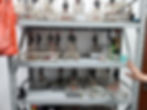PCB Test Jigs: How IoT and Data Improve Testing, Maintenance, and Output
- Aniekpeno Ifeh
- Aug 1
- 5 min read
Updated: Sep 1
In our earlier post, "Comprehensive Guide to PCB Test Jig Design and Implementation," we shared the approach we used to design and build effective test jigs. That guide focused on physical design, like mechanical layout, CAD alignment, materials, and pogo pin placement.
However, test jigs do not stop at building them well. Over time, we saw that the jig could give us more if we added a few smart features. So we began using sensors, simple dashboards, and alert systems. We wanted to get useful feedback before problems created delays. We also wanted to give our operators better tools to help them run tests with less guesswork.
This post explains how we did that. It also covers how to choose the right test method based on your product stage, production size, and team setup. Whether you are building one prototype or producing thousands of boards, we believe this approach will help. We will also talk about team communication and the quiet benefits of test jig monitoring that make a difference in practice.

Why We Decided to Add Monitoring to our PCB Test Jigs
After implementing our design checklist, aligning test points properly, and improving mechanical fit, our jigs became more reliable. But we still found ourselves reacting to failures rather than preventing them. So we added sensors and simple monitoring tools.
This allowed us to move from just building good test jigs to building smart ones with fixtures that help us spot issues early, plan maintenance, and improve design feedback loops. We wanted early signals. So we added pressure and temperature sensors to the jig. We connected them to a microcontroller and built a simple dashboard. Soon, we began to notice patterns:
Lower pressure on test pins usually came before a test failure
Some tests caused more heat buildup than expected
Cable strain increased over time due to repeated motion
Fixture alignment changed slightly during long test runs
This helped us shift from reacting to acting early. That change saved time and gave our technicians a better experience. It also reduced stress during peak production.
How We Built Our Monitoring Setup
We started small. One jig, one sensor, and one screen. This was enough to show that even a basic system could help. We chose parts that were easy to find and set up.
Setup Summary
We picked a jig that was used often and had occasional issues
We added a sensor to check contact pressure from pogo pins
We placed a temperature sensor inside the housing
Everything is connected to a microcontroller with a small screen
We used threshold alerts to spot problems early
Tools and Parts We Used
Pressure sensors with simple output
Temperature sensors placed near hotspots
Open source software like Grafana for the dashboard
A printed bracket to hold the electronics inside the jig
Microcontroller board with basic input and network support
What the Dashboard Showed
Contact pressure for each cycle
Temperature readings during long use
How often each jig had been used
Notes on abnormal readings so we could review them later
This system was easy to understand and gave the team fast feedback. We did not expect it to change everything, but it made our process better almost right away.

What Improved After We Started Monitoring
Even small changes had a big effect. Within a few weeks, we saw clear results across the team.
Fewer Retests
We used to repeat tests when failures were unclear. With pressure data, we could tell when the pins were not making good contact. Fixing the issue early saved a lot of time.
Better Maintenance Planning
We stopped guessing when to replace pins or check parts. Instead, we used usage data and trends. This meant fewer unexpected stops and better use of our time.
Useful Feedback to the Design Team
When we found repeated issues with certain areas of the board, we passed the data to the design team. They adjusted the layout to reduce pressure or shift test points. It helped us avoid the same problem in future builds.
Clearer Support for Operators
The dashboard gave quick feedback. Technicians could understand what was wrong without needing engineering support. That built trust and let them take more control.
Better Team Communication
With data on hand, it was easier to talk across teams. Quality, testing, and design teams could work from the same information. Managers could plan more clearly. It made the process smoother and more open.
Growing the System to Other Fixtures
After we saw the first success, we added monitoring to more jigs. We made a shared dashboard for the whole lab. Some jigs had wired sensors, others used wireless boards.
New Features We Added
Alerts for pressure or heat beyond the normal range
Daily reports for each jig
Counters that reset when parts were replaced
A simple map that showed which jigs had open issues
This helped us plan work, spot patterns, and solve small problems early. It also meant everyone could check the jig status without asking around or guessing.

Choosing the Right Way to Test
In our first post, we compared in-circuit testing and functional testing. Since then, we have also used hybrid setups. Here is how we choose now:
In-Circuit Testing (ICT)
Good for high-volume jobs
Fast once the setup is done
Finds small electrical faults
Works well when the design is stable
Flying Probe Testing
Great for new designs or small builds
Easy to change when needed
Takes more time per board
No fixture required, so lower setup cost
Fixtures with Monitoring
Best for medium-sized runs or growing projects
Helps avoid problems from mechanical wear
Gives useful data to improve future builds
We often use a mix. For example, flying probe for first units, then monitored fixtures for main production. That balance gives speed and flexibility.
What Helped Us Most
Looking back, a few steps made the biggest difference:
Start with one simple improvement. Learn and grow from there.
Track the things that change over time, like pressure and heat.
Ask the people running the tests. Their feedback is fast and honest.
Choose your test method based on your needs now, not later.
Make room to adjust. A jig that works today may need small changes next month.
Keep your feedback loops short. Use what you learn quickly.
Write things down. Notes and photos help you spot patterns.
Key Points to Remember
Sensors can help you act early, not just react
A basic dashboard makes a big difference
Monitored jigs are helpful when things are still changing
Share what you learn with other teams
Simple tools can give strong results
Let your technicians guide you on what is useful
Build systems that grow with your product

Common Questions
What sensors should I start with? Pressure and temperature. These show the most common causes of jig wear and test failure.
Do I need a cloud system? No. Local dashboards work well. You can upgrade later if needed.
Can I use this with flying probe testing? Not in the same way. But you can monitor the test setup for heat and movement.
What if I cannot build a dashboard? Use basic alerts. A light or sound when limits are crossed is a good start.
How long does setup take? Our first setup took about three days. Later ones were faster because we reused the same design.
How do I keep monitored jigs working well? Check the logs once a month. Replace parts based on what the data shows.
What if the numbers do not make sense? Calibrate the sensors and compare with manual checks. Make small adjustments if needed.
Summary
A good jig helps with testing. A smarter one supports the whole team. We started with a strong design, then added basic monitoring. It reduced problems and helped our process improve. Now our technicians solve problems faster and our teams plan better.
This post builds on our previous post on PCB Test Jig Design Guide. If you have used that guide, this is your next step. Try one sensor. Build one simple display. See what it tells you. You might be surprised what you learn.
